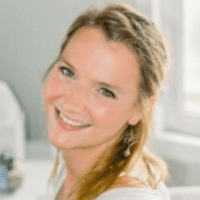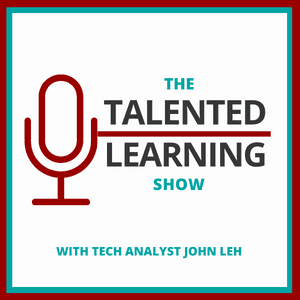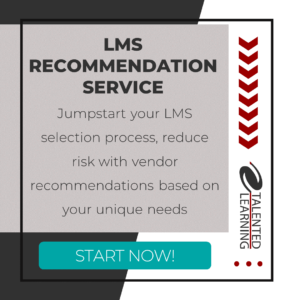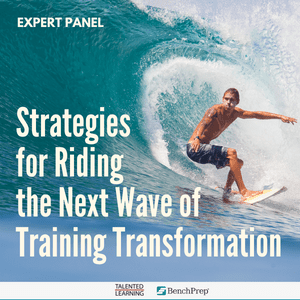
Podcast: Play in new window | Download
Subscribe: Apple Podcasts | Spotify | Amazon Music | Android | iHeartRadio | Blubrry | Email | RSS
EPISODE 69: How Training Improves Access to Nature
One of the most rewarding aspects of my life as a learning systems consultant comes from researching case studies that reveal how powerful learning is in so many contexts. For example, did you know online learning plays a vital role in helping people with disabilities gain access to nature?
Recently, I had the pleasure of meeting Aimee Copeland. She’s a force to be reckoned with who has turned personal tragedy into a life of joy and human transformation. Amy is a talented serial entrepreneur who is on a mission to spread healing and hope. She is the Executive Director of Aimee Copeland Foundation, Founder of Grant Park Counseling Group, and Executive Director of All Terrain Georgia.
After a life-changing accident in 2012, Aimee has become a shining example of how to turn lemons into lemonade — not just for herself, but for anyone with similar challenges who would benefit from access to nature.
Whatever your role as a learning professional, you’ll find inspiring life lessons in Aimee’s story. So join us as we dig deeper on this episode of The Talented Learning Show…
Improving Access to Nature – KEY TAKEAWAYS
- People with mobility challenges must consider safety first. That means access to nature begins with easy access to training, so people know how to safely use assistive devices.
- Online microlearning experiences are proving to be an effective way to educate people who want to understand how to use specialized all-terrain wheelchairs to enjoy local parks.
- By tapping into an online community, it’s easier to engage and educate existing users, and also build broader awareness and enthusiasm through word-of-mouth.
Improving Access to Nature – Q&A HIGHLIGHTS
Welcome, Aimee. Could you tell us about the history behind your foundation?
Well, after a zipline accident almost 12 years ago, my left leg became badly infected and the sepsis spread throughout my bloodstream. In only a month, I effectively became a quadruple amputee.
At first, I thought hikes in the woods probably wouldn’t happen anymore. But the longer I was in rehab, watching daytime television in a hospital bed, surrounded by other people watching daytime television in hospital beds, I realized this population needs ecotherapy the most!
So I got a second master’s degree in social work, focusing on people with disabilities and access to nature. That really fired me up. And I made it my mission to bridge the gap between nature and accessibility.
Wow…
But I wanted to keep the experience wild. No boardwalks, no sidewalks. And I realized that would require technology. That led me to Action Trackchairs, which are all-terrain wheelchairs.
And then I started this foundation, raised money and found supporters who also want to improve access to nature. They helped me get these chairs into local communities, so others can live and play outdoors together with their family and friends.
How do these all-terrain chairs work?
The chairs we use have triangular-shaped tank tires with treads, so they can go up steep terrain. They can navigate through water, snow, sand — you name it. They’re electric. They have zero emissions. And best of all, because the treads distribute the weight of the chair, they don’t disturb the soil. So, when used properly, they leave zero impact.
Also, for those who need an assistant, someone can walk next to them and operate a joystick attached to the side, so people of all ages and abilities can use these chairs for access to nature.
Find out how real-world companies are achieving more with learning systems that create business value. Get inspiration from dozens of success stories in our free LMS Case Study Directory…
Nice. So, where are these chairs located?
Currently, they’re available in 15 Georgia State Parks. And we just started placing chairs in the National Park System in Georgia.
Also, we recently received a grant for a van to move the chairs around, which will allow us to incorporate more parks. So very soon, folks will have access to nature in any Georgia State or National Park that is appropriate for a chair.
So, what kind of training do people need before they use these chairs?
As a trained social worker, I know that when people face risk, they need to be prepared. So we teach people not only how to protect themselves but also how to protect the environment. Specifically, we provide certification based on three elements:
- We require valid proof of identity and proof of disability. This could be an accessible parking placard on their vehicle, or a doctor’s note, or just an explanation in their own words.
- Also, the safety of our participants is of utmost importance. We want to make sure nobody gets hurt out on the trail, so we offer online training to help people learn how to use the chairs safely within their limitations. For example, how steep is an acceptable incline? How can they adjust the seat so it’s comfortable and they don’t get pressure sores, blisters or bruises? And where can they go safely within each park?
- Finally, we want to preserve the ecology of our parks. As a nature lover, I want everyone to enjoy these outdoor spaces for years to come. That’s why we train people in how to operate the chairs appropriately to avoid damaging plants or soil.
Very admirable. How long does it take to complete the training?
It usually takes no longer than one hour to complete the entire learning process, including the final examination.
So I’m sure our audience would like to know more about how you use Learnie, your online learning platform. How does that work?
Well, as soon as we receive a new member’s information, we send them a link so they can join our community on Learnie.
The cool thing about Learnie is that the training content is delivered in short bursts. It’s like TikTok, where you get really quick bites of information. So it’s highly engaging. And community members tell us that learning how to use the chairs is really easy.
Great. So do you encourage community members to upload their own content on Learnie and share it with others?
Yes. Now that we’ve been running the program for a while, we have a lot of dedicated users who are enthusiastic about getting outdoors and improving access to nature. So we want to get people with various kinds of disabilities to submit videos to share their knowledge about how they use the chairs. That makes it more specific for people in different situations to understand, and we can add it to our safety certification process.
Makes sense…
Also, we look forward to expanding this community content in the next year to include member-generated trail alerts.
For example, say you come upon a felled tree you cannot get over. We think it would be cool for you to submit a video of that to our community to inform others about the obstacle. And at the same time, we can notify the Department of Natural Resources so they can correct the problem.
That’s the difference between an LMS and a microlearning social platform. The two-way nature of communication sets it apart…
Yeah. And there’s so much more we’re excited to expand into. For example, think of bird watchers like The Audubon Society. They love our program. So it would be cool for participants to be able to submit wildlife images, audio clips or videos from the trails to educate other people and get them interested in the benefits of access to nature…
Fantastic! So, I imagine these chairs are pretty expensive. How do you provide them for free? And how can people help support your program?…
…For complete answers to this question and more about how training improves access to nature, listen to the full 30-minute podcast on Apple Podcasts, on Google Podcasts, on Spotify, or right here on our site.
Learn More:
Get to Know Learnie!
Want to find out more about the platform that is helping Aimee improve access to nature? Check out the vendor profile, including our product review and more in our Learning Systems Directory. Or visit the Learnie website.
Need Help Finding the Best LMS for Your Organization?
Submit the form below to request a free initial consultation call with our Lead Analyst, John Leh:






